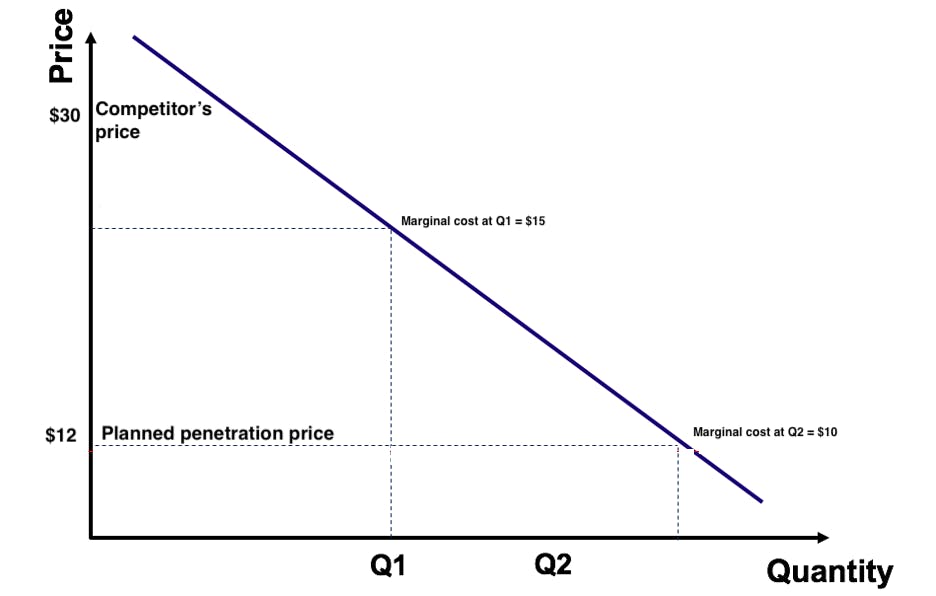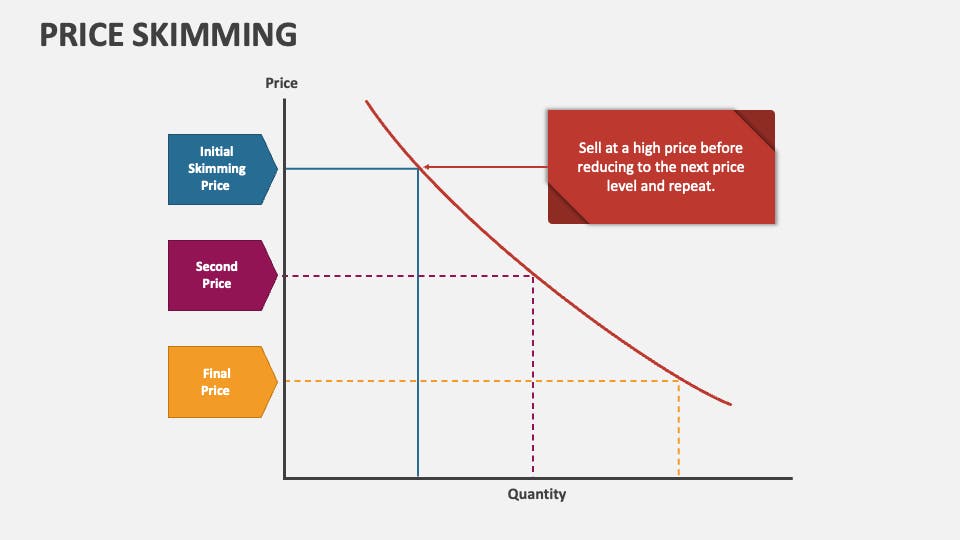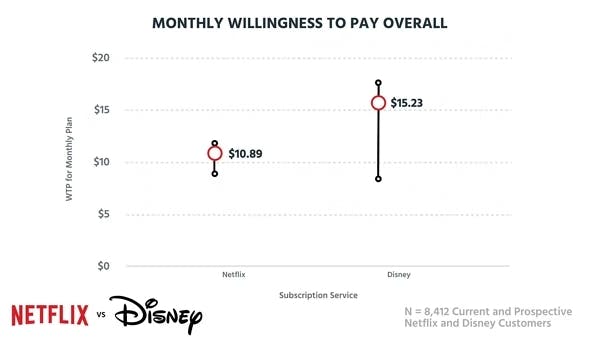Complete guide to penetration pricing strategy
May 9th, 2023

Contents
What is penetration pricing?
How to implement penetration pricing
Examples of penetration pricing strategy
Many consumers are hesitant to switch brands or use new products in markets where customer trust and brand loyalty are the most crucial factors. At the same time, due to high barriers to entry and fierce rivalry, new companies should think outside the box. Businesses should rely on strong and unique differentiators to distinguish themselves from the competition, attract new clients and turn them into devoted buyers. Nothing simplifies the customer decision-making process more than price. This idea serves as the foundation of the penetration pricing strategy.
Companies that implement this method sell new products to customers at discounted prices to present them with the latest offering. Businesses employ this strategy to draw clients and acquire market share. In addition, this pricing method can help companies raise customers’ interest and encourage consumers to switch brands. In this article, we will describe what penetration pricing is, how to use it for your business, and provide examples of world-famous brands that have already implemented this approach.
What is penetration pricing?
Penetration pricing is a pricing method that entails selling a new product or service at a low introductory price to attract consumers. This strategy helps businesses gain new customers by competing solely on price, as opposed to having to contend with well-known names on the value a product or service provides. A penetration pricing strategy's objectives are to generate interest in a product, build brand loyalty and introduce an offering to consumers at minimal risk.

The strategy aims to persuade customers to try a new offering and obtain market share by providing a product at a reduced price. Once companies acquire a large client base, they can raise the price to take advantage of customers’ willingness to pay. The most challenging part of a penetration pricing strategy is the process of increasing prices. Consumers who switch to the less expensive option are more likely to do so again as prices rise.
New market players typically use a penetration pricing method when launching a product or entering a new market. However, precise pricing depends on several variables, including the number of competitors in the market, the similarity of their offerings, and the pricing strategies they implement.
Penetration pricing vs price skimming
Penetration pricing and price skimming are frequently confused. Both strategies are temporary and used to present new offerings. Yet, these pricing techniques have significant differences.
Penetration pricing strategy offers products at discounted prices to create a customer base. The strategy's objective is to enter the market and attract a large number of consumers with limited budgets. With penetration pricing, profit margins are lower for a short time, but high sales volumes should compensate for this.
Companies use this strategy for products that other businesses are already selling. Customers familiar with other companies’ offerings switch to the new low-priced product after the launch. In addition, penetration pricing also deters new rivals from entering the market. As a result, rival companies cannot produce and sell a product at low margins, which enables the business to increase brand awareness.
Price skimming is a strategy that entails setting the highest introductory price a target market will pay and then gradually lowering it. At first, the company sells a limited number of products at high-profit margins. Then, once the demand of the first customers is satisfied, the company reduces the price to appeal to a more price-sensitive consumer segment.

In contrast to the penetration pricing strategy, the goal of price skimming is to maximize revenue from customers with high budgets. The strategy is most suitable for innovative products targeted at early adopters. The product should be unique, difficult to copy, and have no substitutes in the total addressable market. When a company sets high prices, it generates fewer sales than penetration pricing.
Further, we will discuss how to implement the penetration pricing method and how to set the price and increase your customer base.
How to implement penetration pricing
Penetration pricing strategy is most suitable for elastic products, which means that changes in demand are immediately adjusted to price shifts. This method should be limited either by a specific time frame or by offering your product to a particular group of people. Additionally, it works best in markets where numerous businesses offer comparable goods or solutions. Let us explore how to use this strategy for your company.
Step 1. Know your target market
The first step to implementing the penetration pricing method is understanding your ideal client and their financial capabilities. You should also have a good grasp of the needs of your customers and direct your marketing efforts toward satisfying them. Plus, your marketing communication needs to align with your prices to ensure consumers receive a consistent message.
Analyze your existing customer base to consider how your current clients have reacted to prices thus far. Understand how much they are willing to pay for your products and services and whether previous price changes affected customer behavior and sales. Then create more precise customer profiles by using these insights.
Moreover, it is critical to apply an ethical penetration pricing model. Your pricing method might backfire due to the unexpected increase in prices. To avoid consumer dissatisfaction in advance, you can provide free trials or introductory specials. In this case, customers will be ready for further price growth.
Step 2. Identify value metric
The following step is to determine a value metric. It refers to the way a business estimates the value of a single item for selling. For example, if you provide monthly subscriptions, you want to establish the value of services a client can access for a month. Value metric helps you address two important issues: the requirements your ideal client has for a similar product or service and the price the customer is willing and able to pay.
To identify the value metric, you should determine the basic unit of a product you offer. It is crucial to decide on the metric by examining the buyer’s view of the value your product offers rather than the value you believe it provides. Therefore, you need to understand how consumers use your product and the problems they are going to solve with it.
Step 3. Determine your pricing potential and price ranges
Pricing potential is the maximum amount you could charge for your good or service. Consider variables like your operating expenses, customer demand, and competing offerings when assessing the pricing potential for your product or service.
To implement this strategy, you want to decide how low you want to set your prices. No matter how great the demand is, if you charge very low prices, it will be tough for your company to continue operating. Thus, the price should be appropriate both for the buyer and the seller.
When establishing the price range, consider the following. Taking into account the costs of manufacturing, marketing, and advertising, what is the lowest price you may charge for an item or service and still generate a profit? Conversely, what is the highest price you may set for an offering or service without irritating your target market?

Step 4. Examine competitors’ pricing
To implement a penetration pricing model, you need to analyze the prices of competitors’ products. Make a list of similar offerings with the prices. Before implementing your pricing strategy, bear in mind your direct rivals, the switching costs for your buyers, and any indirect influences. Furthermore, analyze the pricing strategies that are typically used for your industry. For example, freemium pricing with different options is the popular model for SaaS companies. These businesses offer clients a method to upgrade products once customers’ requirements grow.
What is more, your brand and business model play a significant role in determining the price of your offerings. Therefore, make sure your pricing strategy is consistent with the brand, as brand identity can impact how customers perceive a company and the quality of its products.
Step 5. Request consumer feedback
Customer feedback is extremely helpful when deciding how to price a new or existing product. Survey current and prospective clients to identify the right price for your offering, the highest price for the product, the acceptable price range, and how likely they would buy the product if it were on sale.
Run a few live experiments to gather information on how your products will perform at various price points. For instance, to determine which price is preferred, you could conduct an A/B test, which involves introducing a product to two audiences at two different prices. To evaluate customer reaction, you could also compare your products to those of your rivals in your marketing messaging.
Testing results and customer feedback can provide you with ideas for effective product launches. In the next section of this article, we will review the examples of several companies that have successfully employed this strategy.
Examples of penetration pricing strategy
Let us consider the examples of penetration pricing strategy in practice. If you implement a penetration pricing method, you can suffer a temporary loss but will contribute to long-term gains.
Amazon
When the company first introduced the Kindle e-reader, Amazon applied penetration pricing. To establish market dominance and position itself as the industry leader, the company set the Kindle price considerably lower than the other products on the market. Despite the abundance of high-tech e-readers in this niche market and the fact that there have been few changes to its technology in recent years, the Amazon Kindle is still a top competitor in the e-book industry for 15 years.
Uber
To attract clients after the launch in new markets, Uber provided discounts and promotional coupons. The food service competition between Uber Eats and Deliveroo in the Belgian market is a prime illustration. To win over Deliveroo's consumers during the coronavirus pandemic, Uber Eats provided a 50% discount on the first five purchases for six months. The company also charged discounted prices for its services to win market share and to compete with established taxi providers.
Gilette
Gilette implemented a penetration pricing strategy when it first presented its razor blades. To draw clients and increase market share, the business fixed the price of the products at a low level. Launching affordable products like Vector, Gillette cleverly applied the penetration pricing strategy to stand out from the competition. The cost of the razor blades was raised once the company had proven to be the industry leader.
Netflix
New Netflix users can try the service for free for 30 days. They advertise unique deals for new clients, such as $10 per month for the first half of the year. Additionally, the company promotes all of its most recent and popular films and television programs. Customers find this offer attractive and sign up for the reduced price.

It is always challenging to find your place in a crowded market. Even if you are sure that your company can compete with established brands, you still need to offer consumers a reason to switch. In some cases, this reason is a chance to save some money. Penetration pricing might be the best strategy for acquiring customers if your market is price-sensitive and you have the resources to compensate for lower profits. Keep in mind that once you create your customer base, you should focus on building your brand and returning lost profits.
